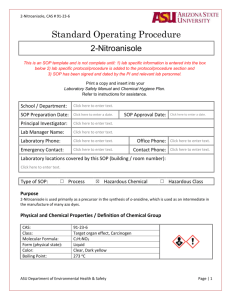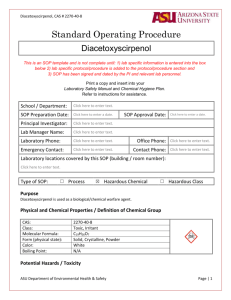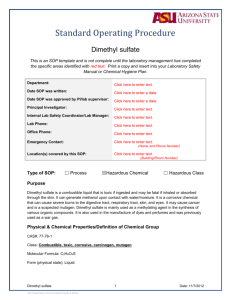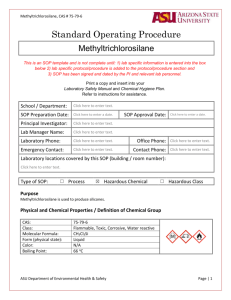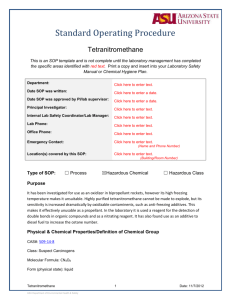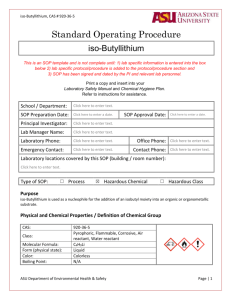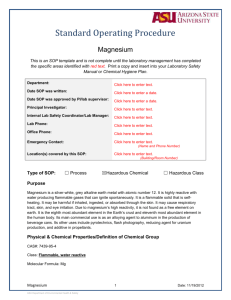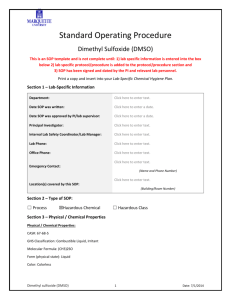Dimethyl Disulfide (DMDS) - Arizona State University
advertisement
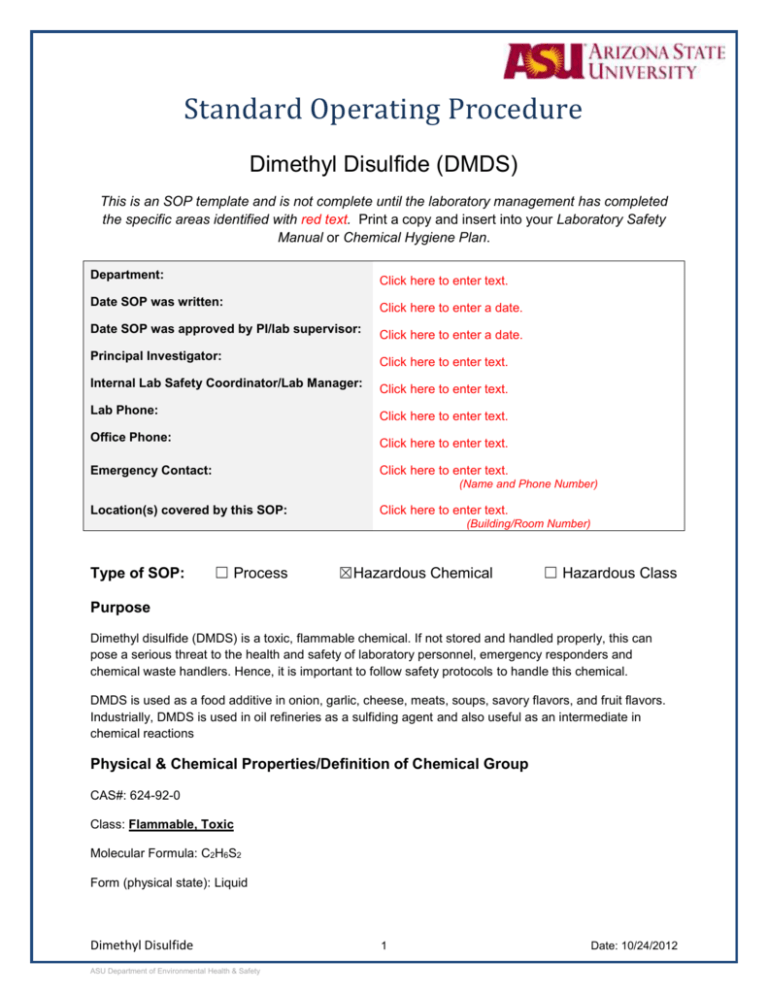
Standard Operating Procedure Dimethyl Disulfide (DMDS) This is an SOP template and is not complete until the laboratory management has completed the specific areas identified with red text. Print a copy and insert into your Laboratory Safety Manual or Chemical Hygiene Plan. Department: Click here to enter text. Date SOP was written: Click here to enter a date. Date SOP was approved by PI/lab supervisor: Principal Investigator: Click here to enter text. Internal Lab Safety Coordinator/Lab Manager: Lab Phone: Click here to enter a date. Click here to enter text. Click here to enter text. Office Phone: Click here to enter text. Emergency Contact: Click here to enter text. (Name and Phone Number) Location(s) covered by this SOP: Click here to enter text. (Building/Room Number) Type of SOP: ☐ Process ☒Hazardous Chemical ☐ Hazardous Class Purpose Dimethyl disulfide (DMDS) is a toxic, flammable chemical. If not stored and handled properly, this can pose a serious threat to the health and safety of laboratory personnel, emergency responders and chemical waste handlers. Hence, it is important to follow safety protocols to handle this chemical. DMDS is used as a food additive in onion, garlic, cheese, meats, soups, savory flavors, and fruit flavors. Industrially, DMDS is used in oil refineries as a sulfiding agent and also useful as an intermediate in chemical reactions Physical & Chemical Properties/Definition of Chemical Group CAS#: 624-92-0 Class: Flammable, Toxic Molecular Formula: C2H6S2 Form (physical state): Liquid Dimethyl Disulfide ASU Department of Environmental Health & Safety 1 Date: 10/24/2012 Color: Light yellow or clear Boiling point: 109 °C Potential Hazards/Toxicity Fire Hazard, Acute Health Hazard, Chronic Health Hazard. Inhalation and skin contact are expected to be the primary routes of occupational exposure to this material. Based on single exposure animal tests, it is considered to be moderately toxic if swallowed, no more than slightly toxic if absorbed through skin, harmful if inhaled, and slightly irritating to eyes and skin. This material has a strong objectionable odor that may cause nausea, headache, or dizziness. The odor threshold is approximately 8 ppb. Oral LD50 LD50 Oral - rat - > 300 mg/kg Inhalation LC50 LC50 Inhalation - rat - 4 h - 1167 - 1471 ppm Personal Protective Equipment (PPE) Respirator Protection Where risk assessment shows air-purifying respirators are appropriate use a full-face respirator with multi-purpose combination (US) or type ABEK (EN 14387) respirator cartridges as a backup to engineering controls. If the respirator is the sole means of protection, use a full-face supplied air respirator. Use respirators and components tested and approved under appropriate government standards such as NIOSH (US) or CEN (EU). Respirators should be used only under any of the following circumstances: As a last line of defense (i.e., after engineering and administrative controls have been exhausted). When Permissible Exposure Limit (PEL) has exceeded or when there is a possibility that PEL will be exceeded. Regulations require the use of a respirator. An employer requires the use of a respirator. There is potential for harmful exposure due to an atmospheric contaminant (in the absence of PEL) As PPE in the event of a chemical spill clean-up process Lab personnel intending to use/wear a respirator mask must be trained and fit-tested by EH&S. This is a regulatory requirement. Hand Protection Butyl rubber, Nitrile gloves are recommended when handling this material. NOTE: Consult with your preferred glove manufacturer to ensure that the gloves you plan on using are compatible with dimethyl disulfide. Refer to glove selection chart from the links below: http://www.ansellpro.com/download/Ansell_8thEditionChemicalResistanceGuide.pdf OR http://www.allsafetyproducts.biz/page/74172 OR http://www.showabestglove.com/site/default.aspx OR Dimethyl Disulfide ASU Department of Environmental Health & Safety 2 Date: 10/24/2012 http://www.mapaglove.com/ Eye Protection Safety glasses or goggles that are ANSI approved. Skin and Body Protection Flame resistant lab coat, closed-toe shoes, and long pants. Hygiene Measures Avoid contact with skin, eyes and clothing. Wash hands before breaks and immediately after handling the product. Engineering Controls Work with this chemical in a certified ducted fume hood. Facilities storing or utilizing this material should be equipped with an eyewash facility and a safety shower. First Aid Procedures If inhaled If breathed in, move person into fresh air. If not breathing, give artificial respiration. Consult a physician. In case of skin contact Wash off with soap and plenty of water. Take victim immediately to hospital. Consult a physician. In case of eye contact Rinse thoroughly with plenty of water for at least 15 minutes and consult a physician. If swallowed Do NOT induce vomiting. Never give anything by mouth to an unconscious person. Rinse mouth with water. Consult a physician. Special Handling and Storage Requirements Precautions for safe handling: Avoid contact with skin and eyes. Avoid inhalation of vapor or mist. Keep away from sources of ignition. Take measures to prevent the build-up of electrostatic charge. Conditions for safe storage: Keep container tightly closed in a dry and well-ventilated place. Containers which are opened must be carefully resealed and kept upright to prevent leakage. Spill and Accident Procedure Chemical Spill Dial 911 and 480-965-1823 Spill – Assess the extent of danger. Help contaminated or injured persons. Evacuate the spill area. Avoid breathing vapors. If possible, confine the spill to a small area using a spill kit or absorbent material. Keep others from entering contaminated area (e.g., use caution tape, barriers, etc.). Small (<1 Liter) – Follow the “Hazardous Materials Incident” guidance in the posted Emergency Response Guide. Dimethyl Disulfide ASU Department of Environmental Health & Safety 3 Date: 10/24/2012 Large (>1 Liter) – Dial 911. Follow guidance for major spill or leak in the posted Emergency Response Guide Chemical Spill on Body or Clothes – Remove clothing and rinse body thoroughly in emergency shower for at least 15 minutes. Seek medical attention. Notify supervisor and ASU EH&S at 480-965-1823. Chemical Splash Into Eyes – Immediately rinse eyeball and inner surface of eyelid with water from the emergency eyewash station for 15 minutes by forcibly holding the eye open. Seek medical attention. Notify supervisor and ASU EH&S at 480-965-1823. Medical Emergency Dial 911 Life Threatening Emergency, After Hours, Weekends And Holidays – Dial 911. Note: all injuries and incidents must be reported to ASU EH&S, 480-965-1823. Non-Life Threatening Emergency –Report to your ASU campus health Services Center (451 E. University Drive, south side of University Drive, west of Palm Walk, Hours: M-F, 8am – 6pm, Sat., 10am – 2pm). Outside of these hours, report to Tempe St. Luke’s ER, 1500 S. Mill Avenue. Note: all injuries and incidents must be reported to ASU EH&S, 480-965-1823. Needle stick/puncture exposure (as applicable to chemical handling procedure) – Wash the affected area with antiseptic soap and warm water for 15 minutes. For mucous membrane exposure, flush the affected area for 15 minutes using an eyewash station. Report to your ASU campus Health Services Center (451 E. University Drive, south side of University Drive, west of Palm Walk, Hours: M-F, 8am – 6pm, Sat., 10am – 2pm). Outside of these hours, report to Tempe St. Luke’s ER, 1500 S. Mill Avenue. Note: all injuries and incidents must be reported to ASU EH&S, 480-965-1823. Decontamination/Waste Disposal Procedure Wearing proper PPE, decontaminate equipment and bench tops using soap and water. Dispose of the used chemical and contaminated disposables as hazardous waste following the guidelines below. General hazardous waste disposal guidelines: Label Waste Attach a completed ASU Hazardous Waste tag to all waste containers as soon as the first drop of waste is added to the container. Store Waste Store hazardous waste in closed containers, in secondary containment and in a designated location Double-bag dry waste using transparent bags Waste must be under the control of the person generating & disposing of it Dispose of Waste Dispose of regularly generated chemical waste within 90 days Call EH&S at 480-965-8554 for questions Empty Containers o Dispose as hazardous waste if it once held extremely hazardous waste (irrespective of the container size) o Consult waste pick-up schedule Prepare for transport to pick-up location Dimethyl Disulfide ASU Department of Environmental Health & Safety 4 Date: 10/24/2012 Check on-line waste tag Write date of pick-up on the waste tag Use secondary containment Protocol/Procedure (Add lab specific Protocol/Procedure here) Click here to enter text. NOTE Any deviation from this SOP requires approval from PI. Documentation of Training (signature of all users is required) Prior to conducting any work regarding this SOP, Principal Investigator or designee must provide to his/her laboratory personnel specific to the hazards involved in working with this substance, work area decontamination, and emergency procedures. The Principal Investigator must provide his/her laboratory personnel with a copy of this SOP and a copy of the MSDS provided by the manufacturer. The Principal Investigator must ensure that his/her laboratory personnel have attended appropriate/required safety training (i.e. Biosafety, Fire Safety & Prevention, Hazardous Waste Management, Laboratory Safety ) or refresher training within the last one year. I have read and understand the content of this SOP: Name Signature Date Click here to enter text. Click here to enter a date. Click here to enter text. Click here to enter a date. Click here to enter text. Click here to enter a date. Click here to enter text. Click here to enter a date. Click here to enter text. Click here to enter a date. Click here to enter a date. Click here to enter text. Dimethyl Disulfide ASU Department of Environmental Health & Safety 5 Date: 10/24/2012
